Matador Network's Blog, page 565
November 9, 2021
The 9 best gay-friendly cities in the US

America the beautiful: purple mountain majesties, fruited plains, and enough rainbow-waving gay-friendly cities to make LGBTQ travelers feel at home across the country.
It’s been a tumultuous journey since early cradles of queer civilization sprouted in major American metropoles following World War II. Areas like the Castro, the West Village, and Boystown have grown, shrunk, and sometimes changed their names to reflect the ever-changing communities that live there. What hasn’t changed is the necessity for gay-friendly cities. According to a 2019 survey by Community Marketing and Insights, the number-one reason LGBTQ people travel is to relax — and for them, relaxing means visiting somewhere they know is queer-friendly, like a well-established gayborhood.
Luckily, travelers are spoiled for choice when it comes to gay-friendly cities in America. Hit up old-school communities that wear their identity on every sidewalk. Disappear into queer locales where lavender life is but an asterisk in their fabric. Modern gayborhoods are as dynamic and diverse as the alphabet-soup mafia that gave them birth. We’ve listed out our favorite safe small towns in the US, now it’s time for these nine gay-friendly cities in America to take center stage.
We hope you love the spaces and stays we recommend in these gay-friendly cities! Just so you know, Matador may collect a small commission from the links on this page if you decide to book a stay. See our full Advertiser Disclosure here.
1. Bushwick, Brooklyn2. Andersonville, Chicago3. The Castro, San Francisco4. The Marmalade, Salt Lake City5. Midtown, Atlanta6. Hillcrest, San Diego7. Short North, Columbus8. Montrose, Houston9. Wilton Manors, Fort Lauderdale1. Bushwick, Brooklyn
Photo: Alessio Catelli/Shutterstock
The West Village might be NYC’s historic gay center, but when it comes to contemporary queer life, Bushwick is the place to be. Contrary to gay-and-lesbian haunts like Chelsea and Hell’s Kitchen, this East Brooklyn nabe lives in the non-binary future. In many ways, the people and bars you’ll find in Bushwick mirror the street art-strewn blocks where they live. They’re eccentric and experimental — the perfect scene for a 20s-something in search of a wild night.
Whatever mischief you’re hoping to find, the clubs of Bushwick will deliver. Chill with a tropical cocktail on Happyfun Hideaway‘s low-key back patio, or eye your astrological match on the dance floor at Zodiac-themed Mood Ring. Hot Rabbit, a femme-flavored pop-up party, is where NYC lesbians go to cut a rug. House of Yes is a mixed queer club where guests dance in glitter-clad costumes after checking identity hangups at the door. If you’re more of a voyeur, see one of the queer-friendly burlesque shows by Company XIV.

Photo: Bushwig/Facebook
Bushwick’s LGBTQ influence extends to neighborhoods just beyond its borders. 3 Dollar Bill — located in East Williamsburg — is Brooklyn’s biggest gay-centric club. Go for high-end drag, midday dance fetes, and weekend circuit parties. The Knockdown Center, tucked into industrial Maspeth, Queens, is the site of Bushwig, an annual drag festival for the city’s funkiest gender benders.
Nightlife isn’t Bushwick’s only calling card. Spend an afternoon touring the area’s hip boutiques and contemporary art galleries, then dine at one of the neighborhood’s trendy restaurants serving international cuisine. Bushwick might be queer, but first and foremost, it’s cool.
Where to stay The Wythe Hotel
Photo: Wythe Hotel
The Wythe Hotel, a chic space with Manhattan skyline views, is a thirty-minute train ride away from all the action.
BKLYN HotelBKLYN Hotel — a minimalistic boutique hotel on the edge of Bushwick — is best for budget-conscious travelers. For those with extra dough, opt for a swankier pad in nearby Williamsburg.
2. Andersonville, Chicago
Photo: Choose Chicago/Adam Alexander Photography 2019
Chicago’s Boystown is dead — literally. In 2020, the neighborhood changed its name to Northalsted — both a joyous move toward gender inclusivity and a sign of the city’s changing landscape. Now, the boys (and everyone else) are flocking north to Andersonville — an area that’s quickly becoming the city’s LGBTQ hotspot.
Queer residents are nothing new to Andersonville. In the 1990s, this neighborhood got the name “Girlstown” thanks to a lesbian population that settled along Clark Street. Today, queer spots cater to an assorted set of locals. SoFo Tap is a laidback bear bar, Atmosphere is a gay den for go-go boys, and Meeting House Tavern provides queer folks a gathering space with board games, theme nights, and a robust selection of brews. Nobody’s Darling, a Black-owned queer cocktail bar, opened to acclaim this past year, attracting a diverse crowd that transcends age, race, and even sexuality.

Photo: Lost Larson
There’s a reason TimeOut voted Andersonville America’s coolest neighborhood in 2021 — and it isn’t all because of LGBTQ residents. Shop for feminist lit at Women and Children First, find antique oddities at Wooly Mammoth, or see a whacky black-box theater production performed by the Neo-Futurists. The neighborhood’s historically Swedish population lives on in Scandi-inspired restaurants like Svea (try the Viking Breakfast), Simon’s Tavern (order a glass of glögg), and Lost Larson, a gezellig cafe. Andersonville is the best of everything rolled into one.
Where to stay Guesthouse Hotel
Photo: Guesthouse Hotel
Staying at the Guesthouse Hotel, located near Andersonville’s southern border, is like living in an apartment. Each suite comes equipped with a full kitchen, preparing you for what life will be like when you realize you want to move here full-time. SoFo Tap and more LGBTQ haunts are all a short walk away.
3. The Castro, San Francisco
Photo: PR Image Factory/Shutterstock
The Castro is America’s quintessential gayborhood: replete with rainbows, littered with LGBTQ businesses, and simmering with queer history. Although rising rents and societal acceptance have pushed out long-time residents to places like nearby Oakland, it’s unlikely the Castro will ever lose its designation as the country’s queer mecca.
Amble along Castro Street, and you’ll see bronze plaques hailing LGBTQ pioneers embedded in the sidewalk. At the corner of Market and 17th, you’ll find the Pink Triangle Memorial honoring gay and lesbian Holocaust victims. The GLBT Historical Society, which preserves and exhibits over a century’s worth of queer history, is a cultural landmark, as is the iconic Pride flag that flies above the neighborhood. The Castro is where Harvey Milk made waves as an openly-gay politician in the 1970s. It’s where communities struggled with — and eventually overcame — the devastating AIDS crisis in the ’80s and ’90s. Twin Peaks Tavern, a watering hole open since 1972, was one of the country’s first gay bars with street-facing windows – a daring design choice in an unforgiving time. Today, you can still sip cocktails inside the vintage space while watching people pass by.

Photo: Verve Coffee
For a perfect Castro day, start by ogling the boutiques on Castro and Market Streets. Get a late-morning pick-me-up at Verve Coffee Roasters. Dolores Park Cafe serves a sensible American lunch. When the sun is shining, join the buff boys in speedos catching rays on the highest corner of Mission Dolores Park. The area, lovingly referred to as the “fruit shelf,” offers sweeping downtown views. At night, Beaux is best for dancing to top 40 pop, Hi Tops is a gay sports bar with surprisingly good food, and Moby Dick is a local queer haunt with pinball and pool. When the historic Castro Theater is open, kick back to enjoy a silver screen classic or catch a local drag show.
Where to stayParker Guest House
Photo: Parker Guest House/Facebook
Most reasonably priced hotels are around Union Square. If you want to stay near the Castro, book a room at the Parker Guest House. This cheery bed-and-breakfast, housed in a classic Edwardian complex, is a block from Mission Dolores Park.
4. The Marmalade, Salt Lake City
Photo: Austen Diamond Photography/Visit Salt Lake
Salt Lake City’s 18,000 square-foot Marmalade District might not cover the same sprawling space as the Castro, but bigger doesn’t always mean better. This tiny residential triangle north of Temple Square is indicative of a surprising fact for anyone who equates SLC with Joseph Smith’s anti-gay disciples: queer life is integrated into the everyday. With the Mormon majority slipping below 50%, several openly-gay elected officials, and an LGBTQ population that rivals Los Angeles, there’s no need for an elephantine gayborhood. Still, it’s nice to know there’s a place where your neighbors likely worship at the altar of RuPaul.
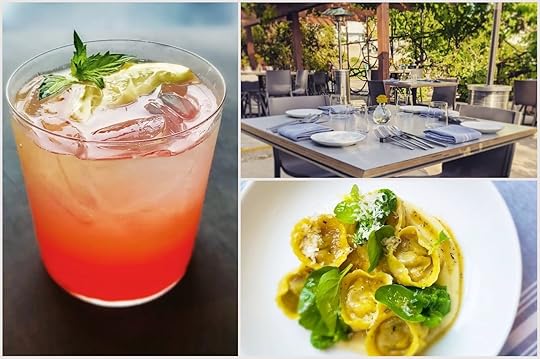
Photo: Arlo Restaurant/Facebook
It’s hard not to confuse street names like Apricot and Quince with the fruit-forward playground slurs thrown around by tween bullies, but the name Marmalade comes from fruit trees planted by early residents. The trees might be gone, but the area is still sweet. When hunger calls, sit down at Arlo for contemporary American cuisine or grab a pastry from District Coffee Co. Once you’re satiated, stroll the fruit streets to peep Gothic and Victorian architecture leftover from SLC’s Mormon heydays.
Marmalade earned the moniker gayborhood after the 2007 opening of Club Jam and the emergence of the original Utah Pride Center. Although both establishments have moved on, it only takes a short drive to reach the city’s queer haunts du jour. Five minutes will get you to Sun Trapp (the city’s most happening gay bar) and Metro Music Hall (a queer-friendly performance venue with glitzy drag shows). Laziz Kitchen, a gay-owned Meditteranean restaurant, is ten minutes away, as is LGBTQ Club Try-angles. Come for the beer-dipped wieners served during summer’s Sunday BBQs.
Where to stayKimpton Hotel Monaco
Photo: Kimpton Hotel Monaco
Give back to the queer community by staying at the Kimpton Hotel Monaco, housed in a historic downtown building from the 1860s. The boutique chain donates a portion of its proceeds to the Trevor Project – a nonprofit that provides suicide prevention services for LGBTQ youth.
5. Midtown, Atlanta
Photo: f11photo/Shutterstock
Atlanta is the LGBTQ stronghold of the South, and Midtown is its epicenter. Although hip spots like Old Fourth Ward and East Atlanta Village are equally vibrant lavender locales, Midtown has reigned supreme as the Big Peach’s go-to gayborhood since the 1970s.
Head to the rainbow-painted crosswalks at 10th and Piedmont for a night of debaucherous bar hopping. Blake’s on the Park started slinging drinks to LGBTQ customers over three decades ago, as did Bulldogs, an unpretentious dive favored by Black men. Ever-inclusive X is a southern bistro by day and a bustling bar by night. My Sister’s Room is a lesbian bar with 25 years under its belt.

Photo: High Museum of Art/Facebook
You don’t have to imbibe to enjoy this LGBTQ mecca. Midtown earns the moniker “Heart of the Arts” thanks to a healthy helping of cultural institutions lining its streets. Step inside the High Museum of Art to see over 18,000 pieces ranging from classic to contemporary, or spend a night enjoying a Broadway musical inside the ornate Fox Theater. Piedmont Park, a 185-acre urban Arcadia along the neighborhood’s north side, gives visitors a chance to escape the city bustle – unless you’re visiting for Black Pride, October Pride, or the annual Joining Hearts circuit party. These raucous meet-ups turn the green space into ground zero for the city’s largest LGBTQ gatherings.
Where to stayThe Georgian Terrace
Photo: The Georgian Terrace
Pretend you’re spooning with Rhett Butler by spending a night at The Georgian Terrace, where stars from the film Gone with the Wind stayed during the 1939 premiere.
Hotel IndigoIf, frankly, my dear, you don’t give a damn about old-school Hollywood, try Hotel Indigo — a sleek, modern spot across the street from the Fox.
6. Hillcrest, San Diego
Photo: San Diego
If the 65-foot Pride flag at the heart of Hillcrest doesn’t prove you’re in the center of San Diego’s LGBTQ sanctuary, walk the neighborhood’s pedestrian-friendly streets. You’ll see rainbows outside Urban Mo’s, the “hetero-friendly” bar and restaurant. There are more rainbows outside Rich’s, a gay club that attracts dance-happy locals. Rainbows welcome guests at Hillcrest Brewing Company, dubbed the world’s first gay brewery, and rainbows greet visitors to the San Diego LGBTQ Community Center, one of the nation’s largest queer support organizations. The neighborhood even named a street after queer icon Harvey Milk and quite literally paved the roads with rainbows.

Photo: Hillcrest Brewing Company
Hillcrest isn’t only about waving flags — it’s also about having fun. Throughout the year, blocks between Washington Street and Balboa Park erupt with celebratory shindigs. Honor Queer Christmas by wearing a costume to Nightmare on Normal Street, a Halloween-themed bash that haunts the neighborhood every October. Trade beads with boys at Hillcrest Mardi Gras, February’s Fat Tuesday fest, or scope out local artisans at CityFest, locally known as “Pride Light.” The neighborhood’s biggest event is undoubtedly San Diego Pride. Every July, over 200,000 people take to the streets for the weekend block party and parade.
Get a taste for local life by strolling around Sunday’s farmers’ market or dining at the LGBTQ-owned insideOUT. Snap a photo of the iconic Hillcrest sign hanging above University Avenue before perusing crafty boutiques and vintage stores.
Where to stayHillcrest House Bed and Breakfast
Photo: Hillcrest House
Make San Diego your home away from home by staying at Hillcrest House Bed and Breakfast. The LGBTQ-friendly digs, located close to the neighborhood’s center, feature five cozy rooms in a two-story home. For something more secluded, rent their historic off-site bungalow, built-in 1915, and updated with modern amenities.
7. Short North, Columbus
Photo: Experience Columbus
When it comes to queer Midwestern cities, Columbus takes the cake. With more LGBTQ residents per capita than Chicago, it’s possible to find slices of gayborhoods in several areas throughout town. For the most significant piece, stop by Short North — the self-identifying arts district sandwiched between Ohio State University and the city’s sprawling sports arena.
Head down High Street, the neighborhood’s artery, and you may wonder if this is a gayborhood at all. Art galleries outnumber gay bars, and street art is more common than Pride flags. Still, if you want a raucous night of dancing to Britney or belting with Barbra, this is the place to be. Axis is the city’s biggest LGBTQ dance club, and gay-friendly Union Cafe serves food, drinks, and a Sunday Showtunes event with a serious following.

Photo: Experience Columbus/Facebook
Every June, the Pride parade marches straight through Short North’s center, and every October, HighBall attracts a queer-leaning crowd to a fashion-forward costume contest. Part of Short North’s appeal is its radical inclusivity. This anything-goes attitude takes corporeal form during the annual Doo-Dah Parade, a July 4th spectacle where the only expectation for participants is kooky self-expression. Like the neighborhood it marches through, the parade isn’t necessarily gay or straight – it’s a celebration of being free.
Where to stayGraduate Columbus
Photo: Graduate Hotel/Facebook
The college-themed Graduate hotel, conveniently located one block from Short North’s gay bars, is part of an expertly-designed boutique chain found in university towns across the country. If you’re looking for quirky charm that matches Short North’s energy, there’s no better place to rest your head. Poindexter, an on-site coffee shop and bar, is a stylish place to study up on all-things C-bus.
8. Montrose, Houston
Photo: Visit Houston Texas/Facebook
In the 1970s, Montrose was described as “the strangest neighborhood east of the Pecos” – a fitting slogan for a neighborhood that defies Texas conservatism by being unabashedly queer. Just like nearby Austin and New Orleans, Montrose is a cultured stronghold for a liberal crowd. The area reached its rainbow zenith in the 1990s when roughly 40 establishments catered to queer folks. Today, there aren’t nearly as many LGBTQ businesses, but Montrose still shines bright as the Lone Star State’s greatest gayborhood.
Most of Montrose’s LGBTQ bars sit in a four-block radius around Crocker Street and Hyde Park Boulevard. There’s food and drinks at JRs, relaxed stetson style at George, and leather-wearing lads at the Ripcord. Buddy’s, an all-are-welcome watering hole, holds the distinction of being the world’s first LGBTQ bar to serve as a presidential voting location.

Photo: The Menil Collection Houston/Facebook
Leave the strip of bars to see the artsy side of Montrose. Contemporary works at the Cy Twombly Gallery and Rothko Chapel are mere footsteps from the Menil Collection, a Renzo Piano-designed museum with over 17,000 pieces in its catalog. Crafty boutiques like Space Montrose and antique stores like Old Blue House line commercial Westheimer Road. The neighborhood’s newer businesses might make Montrose a little less “strange,” but they’re still filled with enough pizzazz to honor its history.
Where to stayHotel ZaZa Museum District
Photo: Hotel ZaZa Museum District/Facebook
Not only does the Hotel ZaZa Museum District share a name with Albin’s drag persona in La Cage aux Folles, it’s just as sexy and refined as Albin could ever hope to be. It’s also centrally located two miles from Montrose and within walking distance to the 445-acre Hermann Park. Be sure to take a peek at the astronaut-themed “Houston We Have a Problem” suite.
9. Wilton Manors, Fort Lauderdale
Photo: Sean Pavone/Shutterstock
Wilton Manors is all LGBTQ all the time. This two-square-mile suburb of Fort Lauderdale is America’s second gayest city, beaten only by Provincetown, and the local government is run entirely by LGBTQ officials. Wilton Manors is so cheerfully queer, they even have a rainbow-clad cop car that says “Policing with Pride.”
Stroll down Wilton Drive, and you’ll have over 40 LGBTQ-owned establishments within your reach. Get your morning caffeine fix from the lads at Java Boys, chow down a Big Girl burger at Rosie’s Bar and Grill, or set up shop at Georgie’s Alibi Monkey Bar, where you can dine, drink, and dance without ever leaving the complex. Bounce to leather bars like Ramrod or the Eagle, watch a game at Gym Sportsbar or play pool at Hunters Nightclub. You can spend an entire night skipping in and out of LGBTQ bars on Wilton Drive and still have more to see.

Photo: Stonewall Museum/Facebook
Wilton Manors’ greatest asset is its proximity to South Florida’s hottest spots. The Stonewall National Museum and Archives, the country’s largest LGBTQ museum, is a ten-minute drive away. Sebastian Street Beach, Fort Lauderdale’s LGBTQ-friendly shoreline, is accessible in twenty minutes. Getting to Miami’s South Beach and the nude section of Haulover only takes an hour. If you start to feel overstimulated by everything LGBTQ, drive to Everglades National Park for some one-on-one time with nature.
Where to stayEd Lugo Resort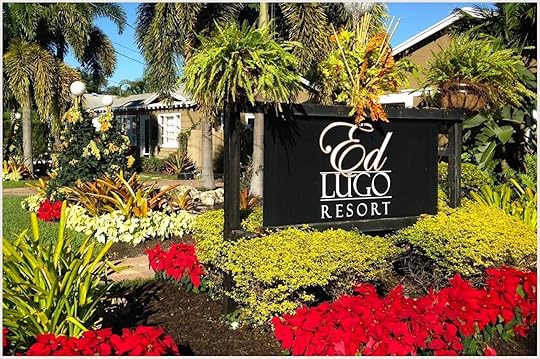
Photo: Ed Lugo Resort/Facebook
Cozy up in a 1950s-style bungalow at LGBTQ-oriented Ed Lugo Resort. Even out your farmer’s tan at the clothing-optional pool area, which feels more South Pacific paradise than South Florida suburb. When you want to see the city’s main sites, Wilton Drive is a short stroll away. 
The 9 best LGBTQ-friendly neighborhoods in the US

America the beautiful: purple mountain majesties, fruited plains, and enough rainbow-waving gayborhoods to make LGBTQ travelers feel at home across the country.
It’s been a tumultuous journey since early cradles of queer civilization sprouted in major American metropoles following World War II. Areas like the Castro, the West Village, and Boystown have grown, shrunk, and sometimes changed their names to reflect the ever-changing communities that live there. What hasn’t changed is their necessity. According to a 2019 survey by Community Marketing and Insights, the number-one reason LGBTQ people travel is to relax — and for them, relaxing means visiting somewhere they know is queer-friendly, like a well-established gayborhood.
Luckily, travelers are spoiled for choice when it comes to urban gay-friendly neighborhoods in America. Hit up old-school communities that wear their identity on every sidewalk. Disappear into queer locales where lavender life is but an asterisk in their fabric. Modern gayborhoods are as dynamic and diverse as the alphabet-soup mafia that gave them birth. We’ve listed out our favorite safe small towns in the US, now it’s time for these nine gay-friendly neighborhoods in America to take center stage.
We hope you love the spaces and stays we recommend! Just so you know, Matador may collect a small commission from the links on this page if you decide to book a stay. Listed prices are accurate as of the time of publication. See our full Advertiser Disclosure here.
1. Bushwick, Brooklyn2. Andersonville, Chicago3. The Castro, San Francisco4. The Marmalade, Salt Lake City5. Midtown, Atlanta6. Hillcrest, San Diego7. Short North, Columbus8. Montrose, Houston9. Wilton Manors, Fort Lauderdale1. Bushwick, Brooklyn
Photo: Alessio Catelli/Shutterstock
The West Village might be NYC’s historic gay center, but when it comes to contemporary queer life, Bushwick is the place to be. Contrary to gay-and-lesbian haunts like Chelsea and Hell’s Kitchen, this East Brooklyn nabe lives in the non-binary future. In many ways, the people and bars you’ll find in Bushwick mirror the street art-strewn blocks where they live. They’re eccentric and experimental — the perfect scene for a 20s-something in search of a wild night.
Whatever mischief you’re hoping to find, the clubs of Bushwick will deliver. Chill with a tropical cocktail on Happyfun Hideaway‘s low-key back patio, or eye your astrological match on the dance floor at Zodiac-themed Mood Ring. Hot Rabbit, a femme-flavored pop-up party, is where NYC lesbians go to cut a rug. House of Yes is a mixed queer club where guests dance in glitter-clad costumes after checking identity hangups at the door. If you’re more of a voyeur, see one of the queer-friendly burlesque shows by Company XIV.

Photo: Bushwig/Facebook
Bushwick’s LGBTQ influence extends to neighborhoods just beyond its borders. 3 Dollar Bill — located in East Williamsburg — is Brooklyn’s biggest gay-centric club. Go for high-end drag, midday dance fetes, and weekend circuit parties. The Knockdown Center, tucked into industrial Maspeth, Queens, is the site of Bushwig, an annual drag festival for the city’s funkiest gender benders.
Nightlife isn’t Bushwick’s only calling card. Spend an afternoon touring the area’s hip boutiques and contemporary art galleries, then dine at one of the neighborhood’s trendy restaurants serving international cuisine. Bushwick might be queer, but first and foremost, it’s cool.
Where to stay The Wythe Hotel
Photo: Wythe Hotel
The Wythe Hotel, a chic space with Manhattan skyline views, is a thirty-minute train ride away from all the action.
BKLYN HotelBKLYN Hotel — a minimalistic boutique hotel on the edge of Bushwick — is best for budget-conscious travelers. For those with extra dough, opt for a swankier pad in nearby Williamsburg.
2. Andersonville, Chicago
Photo: Choose Chicago/Adam Alexander Photography 2019
Chicago’s Boystown is dead — literally. In 2020, the neighborhood changed its name to Northalsted — both a joyous move toward gender inclusivity and a sign of the city’s changing landscape. Now, the boys (and everyone else) are flocking north to Andersonville — an area that’s quickly becoming the city’s LGBTQ hotspot.
Queer residents are nothing new to Andersonville. In the 1990s, this neighborhood got the name “Girlstown” thanks to a lesbian population that settled along Clark Street. Today, queer spots cater to an assorted set of locals. SoFo Tap is a laidback bear bar, Atmosphere is a gay den for go-go boys, and Meeting House Tavern provides queer folks a gathering space with board games, theme nights, and a robust selection of brews. Nobody’s Darling, a Black-owned queer cocktail bar, opened to acclaim this past year, attracting a diverse crowd that transcends age, race, and even sexuality.

Photo: Lost Larson
There’s a reason TimeOut voted Andersonville America’s coolest neighborhood in 2021 — and it isn’t all because of LGBTQ residents. Shop for feminist lit at Women and Children First, find antique oddities at Wooly Mammoth, or see a whacky black-box theater production performed by the Neo-Futurists. The neighborhood’s historically Swedish population lives on in Scandi-inspired restaurants like Svea (try the Viking Breakfast), Simon’s Tavern (order a glass of glögg), and Lost Larson, a gezellig cafe. Andersonville is the best of everything rolled into one.
Where to stay Guesthouse Hotel
Photo: Guesthouse Hotel
Staying at the Guesthouse Hotel, located near Andersonville’s southern border, is like living in an apartment. Each suite comes equipped with a full kitchen, preparing you for what life will be like when you realize you want to move here full-time. SoFo Tap and more LGBTQ haunts are all a short walk away.
3. The Castro, San Francisco
Photo: PR Image Factory/Shutterstock
The Castro is America’s quintessential gayborhood: replete with rainbows, littered with LGBTQ businesses, and simmering with queer history. Although rising rents and societal acceptance have pushed out long-time residents to places like nearby Oakland, it’s unlikely the Castro will ever lose its designation as the country’s queer mecca.
Amble along Castro Street, and you’ll see bronze plaques hailing LGBTQ pioneers embedded in the sidewalk. At the corner of Market and 17th, you’ll find the Pink Triangle Memorial honoring gay and lesbian Holocaust victims. The GLBT Historical Society, which preserves and exhibits over a century’s worth of queer history, is a cultural landmark, as is the iconic Pride flag that flies above the neighborhood. The Castro is where Harvey Milk made waves as an openly-gay politician in the 1970s. It’s where communities struggled with — and eventually overcame — the devastating AIDS crisis in the ’80s and ’90s. Twin Peaks Tavern, a watering hole open since 1972, was one of the country’s first gay bars with street-facing windows – a daring design choice in an unforgiving time. Today, you can still sip cocktails inside the vintage space while watching people pass by.

Photo: Verve Coffee
For a perfect Castro day, start by ogling the boutiques on Castro and Market Streets. Get a late-morning pick-me-up at Verve Coffee Roasters. Dolores Park Cafe serves a sensible American lunch. When the sun is shining, join the buff boys in speedos catching rays on the highest corner of Mission Dolores Park. The area, lovingly referred to as the “fruit shelf,” offers sweeping downtown views. At night, Beaux is best for dancing to top 40 pop, Hi Tops is a gay sports bar with surprisingly good food, and Moby Dick is a local queer haunt with pinball and pool. When the historic Castro Theater is open, kick back to enjoy a silver screen classic or catch a local drag show.
Where to stayParker Guest House
Photo: Parker Guest House/Facebook
Most reasonably priced hotels are around Union Square. If you want to stay near the Castro, book a room at the Parker Guest House. This cheery bed-and-breakfast, housed in a classic Edwardian complex, is a block from Mission Dolores Park.
4. The Marmalade, Salt Lake City
Photo: Austen Diamond Photography/Visit Salt Lake
Salt Lake City’s 18,000 square-foot Marmalade District might not cover the same sprawling space as the Castro, but bigger doesn’t always mean better. This tiny residential triangle north of Temple Square is indicative of a surprising fact for anyone who equates SLC with Joseph Smith’s anti-gay disciples: queer life is integrated into the everyday. With the Mormon majority slipping below 50%, several openly-gay elected officials, and an LGBTQ population that rivals Los Angeles, there’s no need for an elephantine gayborhood. Still, it’s nice to know there’s a place where your neighbors likely worship at the altar of RuPaul.

Photo: Arlo Restaurant/Facebook
It’s hard not to confuse street names like Apricot and Quince with the fruit-forward playground slurs thrown around by tween bullies, but the name Marmalade comes from fruit trees planted by early residents. The trees might be gone, but the area is still sweet. When hunger calls, sit down at Arlo for contemporary American cuisine or grab a pastry from District Coffee Co. Once you’re satiated, stroll the fruit streets to peep Gothic and Victorian architecture leftover from SLC’s Mormon heydays.
Marmalade earned the moniker gayborhood after the 2007 opening of Club Jam and the emergence of the original Utah Pride Center. Although both establishments have moved on, it only takes a short drive to reach the city’s queer haunts du jour. Five minutes will get you to Sun Trapp (the city’s most happening gay bar) and Metro Music Hall (a queer-friendly performance venue with glitzy drag shows). Laziz Kitchen, a gay-owned Meditteranean restaurant, is ten minutes away, as is LGBTQ Club Try-angles. Come for the beer-dipped wieners served during summer’s Sunday BBQs.
Where to stayKimpton Hotel Monaco
Photo: Kimpton Hotel Monaco
Give back to the queer community by staying at the Kimpton Hotel Monaco, housed in a historic downtown building from the 1860s. The boutique chain donates a portion of its proceeds to the Trevor Project – a nonprofit that provides suicide prevention services for LGBTQ youth.
5. Midtown, Atlanta
Photo: f11photo/Shutterstock
Atlanta is the LGBTQ stronghold of the South, and Midtown is its epicenter. Although hip spots like Old Fourth Ward and East Atlanta Village are equally vibrant lavender locales, Midtown has reigned supreme as the Big Peach’s go-to gayborhood since the 1970s.
Head to the rainbow-painted crosswalks at 10th and Piedmont for a night of debaucherous bar hopping. Blake’s on the Park started slinging drinks to LGBTQ customers over three decades ago, as did Bulldogs, an unpretentious dive favored by Black men. Ever-inclusive X is a southern bistro by day and a bustling bar by night. My Sister’s Room is a lesbian bar with 25 years under its belt.

Photo: High Museum of Art/Facebook
You don’t have to imbibe to enjoy this LGBTQ mecca. Midtown earns the moniker “Heart of the Arts” thanks to a healthy helping of cultural institutions lining its streets. Step inside the High Museum of Art to see over 18,000 pieces ranging from classic to contemporary, or spend a night enjoying a Broadway musical inside the ornate Fox Theater. Piedmont Park, a 185-acre urban Arcadia along the neighborhood’s north side, gives visitors a chance to escape the city bustle – unless you’re visiting for Black Pride, October Pride, or the annual Joining Hearts circuit party. These raucous meet-ups turn the green space into ground zero for the city’s largest LGBTQ gatherings.
Where to stayThe Georgian Terrace
Photo: The Georgian Terrace
Pretend you’re spooning with Rhett Butler by spending a night at The Georgian Terrace, where stars from the film Gone with the Wind stayed during the 1939 premiere.
Hotel IndigoIf, frankly, my dear, you don’t give a damn about old-school Hollywood, try Hotel Indigo — a sleek, modern spot across the street from the Fox.
6. Hillcrest, San Diego
Photo: San Diego
If the 65-foot Pride flag at the heart of Hillcrest doesn’t prove you’re in the center of San Diego’s LGBTQ sanctuary, walk the neighborhood’s pedestrian-friendly streets. You’ll see rainbows outside Urban Mo’s, the “hetero-friendly” bar and restaurant. There are more rainbows outside Rich’s, a gay club that attracts dance-happy locals. Rainbows welcome guests at Hillcrest Brewing Company, dubbed the world’s first gay brewery, and rainbows greet visitors to the San Diego LGBTQ Community Center, one of the nation’s largest queer support organizations. The neighborhood even named a street after queer icon Harvey Milk and quite literally paved the roads with rainbows.

Photo: Hillcrest Brewing Company
Hillcrest isn’t only about waving flags — it’s also about having fun. Throughout the year, blocks between Washington Street and Balboa Park erupt with celebratory shindigs. Honor Queer Christmas by wearing a costume to Nightmare on Normal Street, a Halloween-themed bash that haunts the neighborhood every October. Trade beads with boys at Hillcrest Mardi Gras, February’s Fat Tuesday fest, or scope out local artisans at CityFest, locally known as “Pride Light.” The neighborhood’s biggest event is undoubtedly San Diego Pride. Every July, over 200,000 people take to the streets for the weekend block party and parade.
Get a taste for local life by strolling around Sunday’s farmers’ market or dining at the LGBTQ-owned insideOUT. Snap a photo of the iconic Hillcrest sign hanging above University Avenue before perusing crafty boutiques and vintage stores.
Where to stayHillcrest House Bed and Breakfast
Photo: Hillcrest House
Make San Diego your home away from home by staying at Hillcrest House Bed and Breakfast. The LGBTQ-friendly digs, located close to the neighborhood’s center, feature five cozy rooms in a two-story home. For something more secluded, rent their historic off-site bungalow, built-in 1915, and updated with modern amenities.
7. Short North, Columbus
Photo: Experience Columbus
When it comes to queer Midwestern cities, Columbus takes the cake. With more LGBTQ residents per capita than Chicago, it’s possible to find slices of gayborhoods in several areas throughout town. For the most significant piece, stop by Short North — the self-identifying arts district sandwiched between Ohio State University and the city’s sprawling sports arena.
Head down High Street, the neighborhood’s artery, and you may wonder if this is a gayborhood at all. Art galleries outnumber gay bars, and street art is more common than Pride flags. Still, if you want a raucous night of dancing to Britney or belting with Barbra, this is the place to be. Axis is the city’s biggest LGBTQ dance club, and gay-friendly Union Cafe serves food, drinks, and a Sunday Showtunes event with a serious following.

Photo: Experience Columbus/Facebook
Every June, the Pride parade marches straight through Short North’s center, and every October, HighBall attracts a queer-leaning crowd to a fashion-forward costume contest. Part of Short North’s appeal is its radical inclusivity. This anything-goes attitude takes corporeal form during the annual Doo-Dah Parade, a July 4th spectacle where the only expectation for participants is kooky self-expression. Like the neighborhood it marches through, the parade isn’t necessarily gay or straight – it’s a celebration of being free.
Where to stayGraduate Columbus
Photo: Graduate Hotel/Facebook
The college-themed Graduate hotel, conveniently located one block from Short North’s gay bars, is part of an expertly-designed boutique chain found in university towns across the country. If you’re looking for quirky charm that matches Short North’s energy, there’s no better place to rest your head. Poindexter, an on-site coffee shop and bar, is a stylish place to study up on all-things C-bus.
8. Montrose, Houston
Photo: Visit Houston Texas/Facebook
In the 1970s, Montrose was described as “the strangest neighborhood east of the Pecos” – a fitting slogan for a neighborhood that defies Texas conservatism by being unabashedly queer. Just like nearby Austin and New Orleans, Montrose is a cultured stronghold for a liberal crowd. The area reached its rainbow zenith in the 1990s when roughly 40 establishments catered to queer folks. Today, there aren’t nearly as many LGBTQ businesses, but Montrose still shines bright as the Lone Star State’s greatest gayborhood.
Most of Montrose’s LGBTQ bars sit in a four-block radius around Crocker Street and Hyde Park Boulevard. There’s food and drinks at JRs, relaxed stetson style at George, and leather-wearing lads at the Ripcord. Buddy’s, an all-are-welcome watering hole, holds the distinction of being the world’s first LGBTQ bar to serve as a presidential voting location.

Photo: The Menil Collection Houston/Facebook
Leave the strip of bars to see the artsy side of Montrose. Contemporary works at the Cy Twombly Gallery and Rothko Chapel are mere footsteps from the Menil Collection, a Renzo Piano-designed museum with over 17,000 pieces in its catalog. Crafty boutiques like Space Montrose and antique stores like Old Blue House line commercial Westheimer Road. The neighborhood’s newer businesses might make Montrose a little less “strange,” but they’re still filled with enough pizzazz to honor its history.
Where to stayHotel ZaZa Museum District
Photo: Hotel ZaZa Museum District/Facebook
Not only does the Hotel ZaZa Museum District share a name with Albin’s drag persona in La Cage aux Folles, it’s just as sexy and refined as Albin could ever hope to be. It’s also centrally located two miles from Montrose and within walking distance to the 445-acre Hermann Park. Be sure to take a peek at the astronaut-themed “Houston We Have a Problem” suite.
9. Wilton Manors, Fort Lauderdale
Photo: Sean Pavone/Shutterstock
Wilton Manors is all LGBTQ all the time. This two-square-mile suburb of Fort Lauderdale is America’s second gayest city, beaten only by Provincetown, and the local government is run entirely by LGBTQ officials. Wilton Manors is so cheerfully queer, they even have a rainbow-clad cop car that says “Policing with Pride.”
Stroll down Wilton Drive, and you’ll have over 40 LGBTQ-owned establishments within your reach. Get your morning caffeine fix from the lads at Java Boys, chow down a Big Girl burger at Rosie’s Bar and Grill, or set up shop at Georgie’s Alibi Monkey Bar, where you can dine, drink, and dance without ever leaving the complex. Bounce to leather bars like Ramrod or the Eagle, watch a game at Gym Sportsbar or play pool at Hunters Nightclub. You can spend an entire night skipping in and out of LGBTQ bars on Wilton Drive and still have more to see.

Photo: Stonewall Museum/Facebook
Wilton Manors’ greatest asset is its proximity to South Florida’s hottest spots. The Stonewall National Museum and Archives, the country’s largest LGBTQ museum, is a ten-minute drive away. Sebastian Street Beach, Fort Lauderdale’s LGBTQ-friendly shoreline, is accessible in twenty minutes. Getting to Miami’s South Beach and the nude section of Haulover only takes an hour. If you start to feel overstimulated by everything LGBTQ, drive to Everglades National Park for some one-on-one time with nature.
Where to stayEd Lugo Resort
Photo: Ed Lugo Resort/Facebook
Cozy up in a 1950s-style bungalow at LGBTQ-oriented Ed Lugo Resort. Even out your farmer’s tan at the clothing-optional pool area, which feels more South Pacific paradise than South Florida suburb. When you want to see the city’s main sites, Wilton Drive is a short stroll away. 
8 of the most stylish boutique hotels in Sonoma County

Sonoma County is not only ground central for a laid-back wine-country getaway it’s also one of the destinations in the US for cool boutique hotels. While resorts tucked among the vineyards are sprawling and all-encompassing, this new crop of hotels in Sonoma County offer some delightful detours full of well-executed design decisions and a balance of funk and fancy. Wake up in a glamping tent under the redwoods or check into an eco-friendly inn of less than 40 rooms and marry that with innovative cuisine, wellness options, and, of course, bottles of Sonoma County wine. Here’s our selection of the best boutique hotels in Sonoma County.
We hope you love the hotels in Sonoma County we recommend! Just so you know, Matador may collect a small commission from the links on this page if you decide to book a stay. Listed prices are accurate as of the time of publication. See our full Advertiser Disclosure here.
1. Farmhouse Inn
best-boutique-hotels-in-Sonoma-County-Farmhouse-Inn-1

best-boutique-hotels-in-Sonoma-County-Farmhouse-Inn-2

best-boutique-hotels-in-Sonoma-County-Farmhouse-Inn-3

best-boutique-hotels-in-Sonoma-County-Farmhouse-Inn-4
.post-gallery--slider .post-gallery-item-caption {color: #fff;}The Farmhouse Inn is one of the best hotels in Sonoma County. This modern twist on a vintage farmhouse in Forestville tucks in lots of luxuries for guests, like a spa and a Michelin-star chef.
Each of the 25 rooms flaunts farmhouse-chic décor such as ship-lap walls, four-poster beds and white sofa slipcovers. Nightly wine tastings ensure you’re plugged into popular Sonoma County wines. Fireplaces, fresh-cut floral bouquets and Sonoma-made toiletries in each room make the place feel cozy even during winter. This luxury extends to the baths, decked out with either a sauna, steam shower or jetted tub. Dubbed “The Wellness Barn,” this spa provides not only massage treatments but also sound-bath meditations and workshops teaching how to make body products or herbal teas.
Price: $775 per night
2. El Dorado Hotel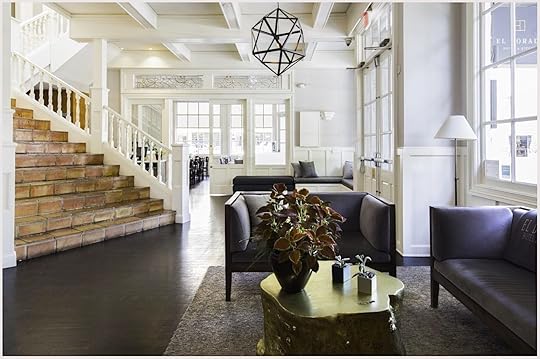
best-boutique-hotels-in-Sonoma-County-El-Dorado-4
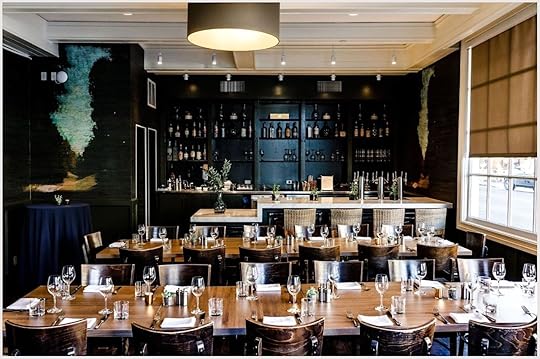
best-boutique-hotels-in-Sonoma-County-El-Dorado-3

best-boutique-hotels-in-Sonoma-County-El-Dorado-2

best-boutique-hotels-in-Sonoma-County-El-Dorado-1
Shouldered by winery tasting rooms, art galleries and boutiques on Sonoma’s plaza is this 27-room hotel, within an 1843 landmark building once home to the brother of Sonoma Valley founder General Mariano Vallejo.
Despite its in-town setting, there’s a saltwater pool on the property and the courtyard is anchored by a 150-year-old fig tree. With balconies, French doors and illy espresso machines, the rooms are great places to hang but if you feel a little wanderlust can hop on a complimentary bike with an adorable basket (to hold any wine purchases). Locals love to sit down at the farm-to-table El Dorado Kitchen, with dining spaces on the patio or inside and a menu orchestrated by Le Bernardin alum Armando Navarro.
Price: $308 per night
3. Boon Hotel and Spa
best-boutique-hotels-in-Sonoma-County-boon-1

best-boutique-hotels-in-Sonoma-County-boon-2

best-boutique-hotels-in-Sonoma-County-boon-3

best-boutique-hotels-in-Sonoma-County-boon-4
Each of the 18 guest rooms at this Guerneville hotel owned by local chef Christa Luedke commit to preserving the earth, like cork floors, organic-cotton bed linens and reclaimed-teak shower mats.
With malm fireplaces, they’re also Scandi-inspired. For a more rugged — but no less refined — accommodation there’s a glamping tent or a refurbished vintage camper. Both the pool and lawn games are fun throwback activities. Scones and French-press coffee delivered to the room means you can linger even longer each morning. If more rest and relaxation is needed, book a massage — choose from an indoor or open-air setting. And if you are feeling adventurous, bright-orange loaner bicycles allow you to explore beyond the property.
Price: $290 per night
4. Wildhaven
best-boutique-hotels-in-Sonoma-County-Wildhaven-1
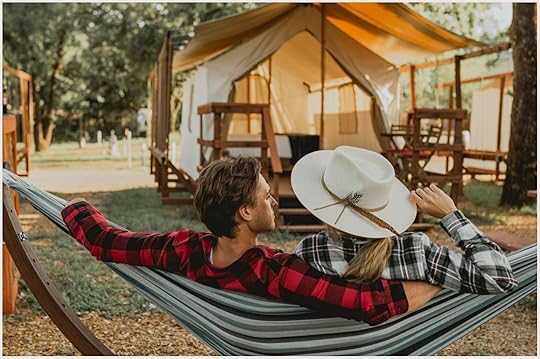
best-boutique-hotels-in-Sonoma-County-Wildhaven-2

best-boutique-hotels-in-Sonoma-County-Wildhaven-3
Wildhaven sits on a 10-acre property along the Russian River. The property caters to campers and outdoor lovers who want a little pampering.
Each of the 40 glamping tents has outlets to charge your phone and either one or two queen-size memory-foam mattresses that are, thankfully, not on the floor but in snazzy bed frames instead. You also don’t have to give up hot showers: simply walk over to the modern shower building. Participating in yoga classes or listening to live music are two of the ways you can get to know other guests. While there’s no restaurant, a communal outdoor kitchen and your very own fire pit make grilling a breeze. S’mores kits and bottles of wines round out this upscale outdoor-sleeping experience.
Price: $120 per night
5. h2hotel
best-boutique-hotels-in-Sonoma-County-h2hotel-3

best-boutique-hotels-in-Sonoma-County-h2hotel-4

best-boutique-hotels-in-Sonoma-County-h2hotel-2

best-boutique-hotels-in-Sonoma-County-h2hotel-1
For a city-type experience, booking one of the 36 rooms at this hotel a block from downtown-Healdsburg’s plaza is among the closest you’ll find in Sonoma County.
Watch the sunset over drinks at the rooftop lounge or enjoy themed dinners — such as fried chicken Wednesdays — in the bustling street-level Spoonbar that opens out onto the street. Or take a self-guided tour of modern, local art … simply by strolling around the hotel. Three room categories — eco-king, eco-studio and eco-suite — are adorned with Heath-ceramic tiled walk-in showers or Japanese-inspired soaking tubs in the baths, along with a private patio to further take in this hip town’s vibe.
Price: $405 per night
6. Timber Cove Resort
best-boutique-hotels-in-Sonoma-County-Timber-Cove-Resort-3

best-boutique-hotels-in-Sonoma-County-Timber-Cove-Resort-1

best-boutique-hotels-in-Sonoma-County-Timber-Cove-Resort-2

best-boutique-hotels-in-Sonoma-County-Timber-Cove-Resort-4
If you really want to get away from wine country — and move closer to the waves, from a perch just above — this 46-room retreat on 25 acres of Pacific Ocean coastline in Jenner is your utopia.
One of the best hotels in Sonoma Country, the 1963 resort reopened in 2016 with a completely new look. All interiors were designed by The Novogratz, a widely known Los Angeles design firm with a young, artsy couple at the helm who also sell a furnishings line through Target. Each guest room boasts a Crosby record player, a mini bar stuffed with Sonoma-made snacks, and a yoga mat. There’s something for everyone on the property, including three miles of hiking trails as well as “wine down” evenings on Tuesday and Thursday where local-winery pours are the focus. Coast Kitchen’s all-day, localized menu is served in the dining room, near an outdoor fire pit, in the lobby bar, or overlooking the ocean from an outdoor patio. An artist-in-residence provides the tunes every Wednesday night.
Price: $560 per night
7. Hotel E
best-boutique-hotels-in-Sonoma-County-hotel-E-3
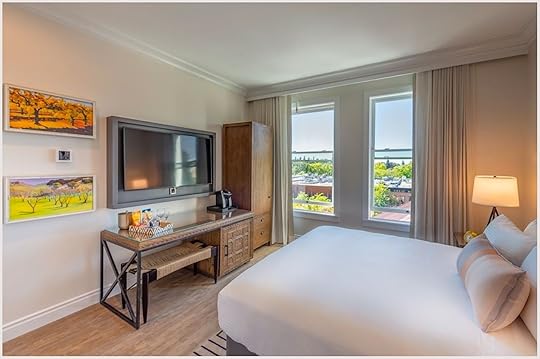
best-boutique-hotels-in-Sonoma-County-hotel-E-1

best-boutique-hotels-in-Sonoma-County-hotel-E-2
Within Sonoma County’s most populated city of Santa Rosa, the 71-room Hotel E is on Old Courthouse Square.
A rooftop lodge and restored Beaux-Arts architecture are serious eye candy. Black-and-white framed photos of the area as well as original art are in each guest room. For a glass of wine, head to the rooftop lounge or the lively Enology Lounge in the lobby. Locals will recognize Perry’s Santa Rosa, an offshoot of the famed San Francisco restaurant’s three locations and serving steaks, burgers, cobb salads and additional diner fare. Note that the rooftop lounge plans to reopen in 2022 along with a revamped outdoor courtyard.
Price: $180 per night
Rock House Suites
best-boutique-hotels-in-Sonoma-County-Rock-House-Suites-2

best-boutique-hotels-in-Sonoma-County-Rock-House-Suites-3

best-boutique-hotels-in-Sonoma-County-Rock-House-Suites-1

best-boutique-hotels-in-Sonoma-County-Rock-House-Suites-4
Perfect if you can’t decide between an Airbnb and a boutique hotel, or you need to book two suites, these accommodations in downtown Healdsburg, near the town’s plaza, are affiliated with Wilson Artisan Wines.
Aptly named The Cloud Suite and The Garden Suite, each is newly renovated with ship-lap walls and a kitchenette. Either suite offers space to spread out with outdoor spaces you can access — a rose-filled courtyard with a fire pit in one or a quaint patio in another. Or, you can get cozy back at the room, thanks to fireplaces and spa-like baths after the tasting rooms close for the night. Many are even within a few blocks’ radius so you can ditch the car for a rather unique tour of Sonoma County wineries. 
Price: $410 per night
More like thisWhere to StayBest Airbnb’s in Puerto Rico from city houses to coastal villasNovember 8, 2021
7 convenient snacks to fuel you through your next backcountry ski trip

Skis might be your vehicle of choice on a backcountry mountain expedition, but snacks are the fuel that keep you going. While overpriced chicken fingers and cheeseburgers that resemble cheeseburgers in name only are always available at a ski resort, if you’re planning a full day in the backcountry, a lodge cafeteria won’t exactly be at your fingertips. To stay nourished and energized for the backcountry, you’ll need to plan ahead.
According to studies, a mixture of healthy carbs and protein are the ideal combination for keeping your energy up, and reducing the potential for muscular injury. Allen Tran, Head Chef of the US Ski Team, told Ski magazine that a balance of fast-burning carbs like what you can get from sports drinks or juice along with slower-burning carbs like peanut butter sandwiches and whole wheat bread is ideal. Carbohydrates are especially important for both stamina and muscle exertion, a Mississippi State University study found. When it comes to winter sports like skiing and snowboarding, which take place in cold temperatures and often at high altitudes, even more attention must be paid to your nutrition.
A study published in the Journal of Sports Sciences examined the ideal nutrition for winter sports and found that “the most important nutritional challenges for winter sport athletes exposed to environmental extremes include increased energy expenditure, accelerated muscle and liver glycogen utilization, exacerbated fluid loss, and increased iron turnover.” Replenishing these lost nutrients is therefore crucial to a successful (and safe) day in the backcountry.
We drew from experience and connected with the pros to narrow down the best snacks to bring on this winter’s backcountry ski adventure, from ready-to-eat Pop-Tarts to pre-prepared baked potatoes.
We hope you love the products we recommend! Just so you know, Matador may collect a small commission from the links on this page if you decide to make a purchase.
1. Bagel with bananas and peanut butter
Photo: Stephan Schlachter/Shutterstock
This DIY snack might give you the best bang for your buck. Just take your bagel of choice, and load it up with peanut butter and banana slices. It’ll give you plenty of carb-fueled energy, potassium, and healthy fats in a small, easy-to-transport package. After a hearty breakfast, two of these bagel sandwiches evenly spaced throughout the day should be enough to keep you going. There’s even a company that sells peanut butter in a pouch, which is perfectly designed for the slopes when you don’t want to take the whole jar with you. Peanut butter is a common ingredient in ski snacks for a good reason. WebMD notes that it’s full of protein and healthy fats that will give you a much-needed energy boost, as well as being a great source of Vitamin E, B6, and magnesium.
2. Dried mangos and figs
Photo: Brent Hofacker/Shutterstock
Dried fruit is an old hiking standby, and by the same token, it’s also great for skiers. Dried fruits are rich in vitamins, proteins, and fiber, and full of juices that help you hydrate. Michael Shaffer, pro skier with Black Crows Skis, prefers dried mangoes and figs in particular.
“Dried mangoes are nice as they create saliva and are easy to swallow while moving,” he says, “but figs pack more of a potassium punch.”
Other dried fruits like dates are also rich in the vitamins, proteins, minerals, and natural sugars that are invaluable for skiers out for a long day in the backcountry. Apricots are another option, providing 47 percent of your daily vitamin A needs in just one serving. They’re also a key source of potassium.
3. Pop-Tarts
Photo: JJava Designs/Shutterstock
Hear me out on this one. What’s the one thing you crave most when you’re in the middle of nowhere, tired, and maybe a little lost? Something familiar. Something comfortable. What’s more familiar and comfortable than Pop-Tarts? Sure, if you’re at home sitting by the fire, comfort food means mashed potatoes and chicken fingers. On skis in the middle of the woods, comfort food means whatever takes the edge off your hunger, fits in your pocket, and yanks you back in time to a safer, more innocent place. Enter Pop-Tarts.
They might not be as nutritious as trail mix, and should definitely be consumed in moderation, but the nostalgia factor and sugar kick is more than enough to keep you going. Too much sugar will cause you to crash, but a small amount will give you a healthy dose of energy. According to Medical News Today, “sugar is a form of carbohydrate” and “the body breaks down carbohydrates into glucose, which enters the bloodstream and acts as a source of energy.” Besides, with more flavor options than calories per serving, you’ll never get sick of them.
4. Pizza
Photo: Bernsten/Shutterstock
Everyone loves pizza. It doesn’t take much arguing to convince someone to grab a slice in pretty much any situation, and that includes backcountry skiing. The only question is — is it convenient? Surprisingly, the answer is yes. Don’t worry, you won’t be buying one of those $5 frozen pizzas and thawing it with your body heat. Order a legit pie the night before your ski adventure, cut it into quarters, fold those quarters, and put them into large ziploc bags. Not all foods taste great as leftovers, but pizza is certainly one of them. As a great source of protein and energy-fueling carbs, it’s not as unhealthy as you might think, either.
5. Small red baked potatoes
Photo: Alexlukin/Shutterstock
Don’t imagine a piping hot, restaurant-style baked potato loaded with sour cream stuffed into your jacket pocket, emerging all squished and gross. Instead, imagine a carefully pre-prepared snack sitting safely in a ziploc bag or wrapped in tinfoil.
“If you’re in for a full day in the backcountry, coat small baked potatoes with olive oil, salt, pepper, and garlic powder, bake them the night before and just pop ‘em in your mouth every hour or so,” Shaffer says.
It might sound odd, but you can’t argue with the pros.
6. Marge Bars
Photo: Marge Bars/Facebook
These dense snacks are like a protein bar and granola bar combined. Marge Bars were created as a snack for hikers who crave a heavy nutritional punch. Each Marge Bar is made with whole grain extra thick rolled oats, all natural peanut butter, honey, dry roasted and unsalted slivered almonds, brown sugar, dried coconut, dried cranberries, milk, white chocolate, and vanilla. It’s basically all the other ski snacks you’ve ever heard of rolled into one. Each bar is two servings, and with 12 grams of healthy fat, 6 grams of protein, and 32 grams of carbs per serving, there’s really no need to pack anything else.
7. PB&J
Photo: Joshua Resnick/Shutterstock
This one needs no explanation. A classic peanut butter and jelly sandwich checks all the boxes — easy to make, portable, cheap, tasty, and more nutritious than you might think. There’s a reason ESPN Magazine called PB&Js a “staple snack” of NBA athletes. Though simple on its face, this classic snack has around 15 grams of protein per serving, and 12.5 grams of sugar for a much-needed quick release of energy. In addition to the well-documented health benefits of peanut butter, jams are packed with plants and fruits that give us energy and fiber, which help curb hunger.
Just prepare a few of these bad boys the night before, stuff them in sealable bags, and they’re ready to go. You don’t even have to worry about them becoming messy and gross while you ride, because let’s be honest — they start out pretty messy and gross. They also taste great cold, and take up virtually no room in your jacket or bag, so there’s plenty of space for other snacks as well.
11 of the deadliest concert disasters in recent history

Many of the world’s deadliest concert disasters have one thing in common: massive crowds. Surges of people can make events dangerous, as seen during the Astroworld Festival in Houston, Texas, on Nov. 5, 2021. Sadly, it’s far from the first time that people have died at a concert or music festival. Not including the 2017 terror attacks at the Ariana Grande concert in Manchester Arena and the Route 91 Harvest music festival in Las Vegas, crushing crowds and fires have caused some of the most dangerous and deadly concert tragedies.
These are 11 of the deadliest concert disasters in the last 50 years.
11. Astroworld Festival
Nov. 5, 2021 — Houston, Texas
Deaths: 8
Surging crowds at Travis Scott’s Astroworld music festival led to pandemonium that turned fatal. The chaos started when Scott, the festival’s founder and headliner, took the stage. The crowd rushed to the front of the stage, with people squeezing together so tightly that many couldn’t breathe. Some suffered cardiac arrest. Eight people were ultimately pronounced dead, and dozens more rushed to the hospital in what was officially classified a mass casualty incident.
10. Roskilde Festival
June 30, 2000 — Roskilde, Denmark
Deaths: 9
In 2020, nine men were killed at a Pearl Jam concert when people rushed the stage and those in front collapsed. According to the BBC, the band was told to stop playing, and once aware of the problem they asked fans to back away, but it was too late. Several had fallen and the crowd pressed on, suffocating those at the bottom of the pile. Pearl Jam later referenced the incident in the song “Love Boat Captain” with the line “Lost nine friends we’ll never know.”
9. The Who at Cincinnati Riverfront Stadium
Dec. 3, 1979 — Cincinnati, Ohio
Deaths: 11
More than 18,000 tickets were sold for The Who’s concert at Cincinnati Riverfront Stadium, and there were only 25 police officers allotted for crowd control. The set was to begin at 8 PM, but the doors were still closed at 7:45 when an anxious crowd, hearing The Who’s warmup and mistaking it for the opening number, surged toward the doors.
General admission seating made up 80 percent of tickets sold, which was said to be a contributing factor to the rush for entry as fans clamored for a good view of the show. As a result of the tragedy, new regulations were put into effect to keep order during large concerts that are still practiced today.
8. Mawazine Festival
May 23, 2009 — Rabat, Morocco
Deaths: 11
This nine-day festival, according to Al Jazeera, was meant to promote the reputation of Morocco as a modern nation. Many international stars played the event, including Stevie Wonder, Kylie Minogue, and Ennio Morricone. On the final night as the festival came to an end, after a set by Moroccan singer Abdelaziz Stati, 11 people were crushed to death.
According to the BBC, attendees blamed the tragedy on the police who closed several exits, ushering the crowds through others “that were not destined for the purpose.” The official line was that fans, too eager to leave, climbed fences, and one of them collapsed, causing the 11 deaths.
7. Love Parade
July 25, 2010 — Duisburg, Germany
Deaths: 21
Berlin refused to host the Love Parade in 2010, citing safety concerns over the size of the crowd. The event was also canceled in 2009 in Bochum due to the inability to host so many spectators. In 2010, it was hosted in Duisburg.
There, an underpass that led to the concert grounds became clogged with people who entered the tunnel despite no one being let into the festival at the time. Panic in the tunnel left 19 dead at the scene. Two survivors later died in the hospital as a result of their injuries.
6. Ghost Ship Fire
Dec. 2, 2016 — Oakland, California
Deaths: 36
At an underground electronic music party in Oakland, a fire broke out that trapped and killed 36 people. The incident took place in a former warehouse-turned-artist-collective venue called the Ghost Ship, which had no smoke detectors or sprinklers, and contained a significant amount of flammable material. It was the deadliest mass casualty event in Oakland since the Loma Prieta earthquake in 1989.
5. Indiana State Fair Stage Collapse
August 13, 2011 — Indianapolis, Indiana
Deaths: 56
Strong winds upended the metal scaffolding and stage equipment at the 2011 Indiana State Fair while a crowd was packed into the concert venue. Audiences had been waiting for an outdoor performance by Sugarland when 70 mile-per-hour wind blew through the fairground and caused the stage to collapse. The disaster resulted in the tragic deaths of 56 concert-goers.
4. Santika Nightclub Fire
Jan. 1, 2009 — Bangkok, Thailand
Deaths: 100
It’s unclear what started the fire in Santika Nightclub while hundreds rang in the new year and the band Burn played. Some mention sparklers, some say there may have been an electrical problem, others say it started as a result of pyrotechnics in the club. It’s possible that fireworks from outside the club started the blaze.
Other known facts are that the club was never sanctioned as such and never received a fire inspection. It was equipped with one fire extinguisher for the entire building and inspection papers were forged to keep the club operating. Exits had been welded shut to prevent patrons from skipping out on their bills, which meant that marked exits were non-existent. Sixty-six people ended up dead from the resulting fire.
3. Station Nightclub Fire
Feb. 20, 2003 — West Warwick, Rhode Island
Deaths: 100
Crowds were well past fire capacity the night of the Station Nightclub Fire, and 100 people died while watching the band Great White. The band’s tour manager set off some pyrotechnics that set insulation ablaze, and it took a while for the audience to understand that the flames weren’t part of the show.
Once they did, there was a mass exodus, but most tried to leave the way they’d entered. The ensuing stampede crushed and knocked over many, and people died from suffocation, smoke inhalation, or were claimed by the fire itself — including Great White’s lead guitarist, Ty Longley.
In January of 2010, the club’s owners, the foam manufacturers of the hazardous and toxic building insulation, Anheuser-Busch, Clear Channel Broadcasting, and the town of West Warwick settled for $176 million to be distributed among the survivors of the fire and the children and families of those who perished.
2. Beverly Hills Supper Club Fire
May 28, 1977 — Southgate, Kentucky
Deaths: 165
The Beverly Hills Supper Club was a sprawling maze of a club in Kentucky, located just across the bridge from Cincinnati, Ohio. Several events were going on at the same time on the night of the fire, including banquets, receptions, and a concert — all connected by narrow passageways within the same structure.
The exact cause of the fire was never determined, but what is known is that the fire was well underway when it was discovered by two waitresses. The ornate Cabaret room, where two comics were warming up an audience of at least a thousand people in a space meant for about 600, held the majority of the building’s occupants.
A busboy, Walter Bailey, stopped the show to make an announcement about the fire. Several people made their way toward the exits he’d pointed out while others didn’t take the threat seriously. When the fire reached the room, the crowd panicked and people were trampled as they tried to escape.
1. Cromañón Fire
Dec. 30, 2004 — Buenos Aires, Argentina
Deaths: 194
Cromañón was a rock club in Barrio Once in Buenos Aires. The night of the fire, República Cromañón was packed with an estimated 3,000 revelers there to see the band Callejeros — nearly three times the crowd size that the club was zoned for.
The club had several doors that were permanently locked shut, and emergency exits were fenced off to prevent people from sneaking in and avoiding a cover charge. República Cromañón was about a month overdue for a fire inspection at the time of the incident and had no sprinkler system. A fire enveloped netting near the ceiling and quickly spread. Most of the nearly 200 casualties were the result of inhaling smoke and toxic fumes rather than being crushed or burned.
A version of this article was previously published in 2011, and was updated on Nov. 8, 2021.
Best Airbnb’s in Puerto Rico from city houses to coastal villas

It’s only 100 miles long and 35 miles wide, but Puerto Rico has a lot to love. The Caribbean archipelago is a haven for beach lovers, a playground for adventure seekers and a place where foodies rejoice. Start in San Juan, where the beach is always close, or get off the grid in the mountains of Cayey. In Vieques, famous for its bioluminescent bay, there’s an 80’s cliffside villa. And a stay in Rincón’s surfer’s paradise means rooftop sunsets and breezy beachside condos. If you’re looking for the best Airbnb in Puerto Rico, here’s our selection that will guarantee an unforgettable stay.
We hope you love the spaces and stays we recommend! Just so you know, Matador may collect a small commission from the links on this page if you decide to book a stay. Listed prices are accurate as of the time of publication. See our full Advertiser Disclosure here.
The best Airbnb rentals in San Juan, Puerto RicoThe best Airbnb rentals in Rincón, Puerto RicoThe best Airbnb rentals in Vieques, Puerto RicoThe best Airbnb rental in Cayey, Puerto RicoThe best Airbnb rentals in Luquillo, Puerto RicoThe best Airbnb rental in Monte Carmelo, Puerto RicoThe best Airbnb rentals in San Juan, Puerto RicoThere’s more to Puerto Rico’s capital city than meets the eye. Beaches, street art, salsa dancing in the streets, and some of the island’s most important historic forts call San Juan home.
1. Spacious house on the beachfront
Photo: Airbnb
Condado is one of San Juan’s most popular neighborhoods. The shoreline is packed with exciting restaurants and nightlife, and this Airbnb is in the heart of it all.

Photo: Airbnb
Here you’ll wake up to floor-to-ceiling window views of the beach in a breezy, ocean-inspired setting. Spacious enough for six guests, Rob and Kat’s place is excellent for medium-sized groups looking for somewhere convenient and comfortable to stay in the capital city.
Six guests, two bedrooms
Price: $350 per night

Photo: Airbnb
Escape the hustle of San Juan at this peaceful paradise apartment. While the living space is artfully-designed and airy, the star here is the outdoor patio.

Photo: Airbnb
Soak up the sun on the shaded terrace surrounded by palms, and don’t leave before indulging in the green-tiled outdoor shower. Maria’s place feels like a place of refuge in the Ocean Park Beach Neighborhood–steps away from Lozia Street, where local bites and street art live.
Four guests, two bedrooms
Price: $211 per night

Photo: Airbnb
Terracotta tiles, a plant-filled atrium, and a Spanish-inspired spiral staircase make this charming home an excellent option for mid-sized groups.

Photo: Airbnb
Just outside your doors is the heart of Old San Juan. Cobblestone streets lead to cultural must-sees like the historic fort, Castillo San Felipe del Morro, and Cuban-inspired speakeasy, La Factoria.
Eight guests, four bedrooms
Price: $291 per night

Photo: Airbnb
Wake up feeling inspired in this art-filled Airbnb in Puerto Rico. It’s airy, full of natural light, and the walls are adorned with plants and local artists’ artwork.

Photo: Airbnb
The three-bedroom space is ideal for mid-sized groups looking for an intimate stay that allows room to spread out with a living area, dining table, open kitchen, and balcony. Step foot outside into the Ocean Park neighborhood of Puerto Rico’s capital city, and you’ll find spots to windsurf or paddleboard, the Museum of Contemporary Art, or the street murals of Santurce.
Eight guests, three bedrooms
Price: $313 per night
A trip here means eight miles of coastline where the Caribbean sea meets the Atlantic. Rincón is a lowkey town of leisure best suites for surfers and nature lovers in need of relaxation.
5. A tropical suite and private pool close to Rincón’s best snorkeling
Photo: Airbnb
Here you can leave your worries at the villa door. Tropical Suites in Rincón have everything you need to relax with the one you love: a king-sized bed, private swimming pool, a large stand-alone tub, and a rooftop terrace.

Photo: Airbnb
If you ever decide to leave the comfort of your suite, the best beaches in town are just three minutes away, along with Rincón’s lighthouse, Faro de Punta Higüera, and a host of restaurants and bars.
Two guests, one bedroom
Price: $168 per night

Photo: Airbnb
Step into bohemian bliss at this one-bedroom suite in the mountains of Rincón. The villa has an airy feel with plenty of natural wood decor and an outdoor, poolside tub–the best of both worlds.

Photo: Airbnb
The living area is intimate with an entertainment center and a cozy open concept kitchen. If you’re looking for somewhere to get away to rest, this is the place for you.
Two guests, one bedroom
Price: $297 per night

Photo: Airbnb
This Mediterranean-inspired villa is an Airbnb in Puerto Rico you won’t forget in a hurry. It sits right on the ocean in the sleepy Barrero neighborhood.

Photo: Airbnb
There’s a lot to love with private beachfront access, two pools, a relaxing gazebo, and cozy hammocks. Wood interiors with pops of colors and floor-to-ceiling windows make this place a breezy stay. And it’s ideal for large groups with six bedrooms and five bathrooms — there’s a whole lot of space for a quiet getaway just two minutes away from restaurants and bars and ten minutes from the center of town.
Fourteen guests, six bedrooms
Price: $1,650 per night

Photo: Airbnb
Ricon, where the Caribbean sea meets the Atlantic, has some of the best sunsets in Puerto Rico. And with this beachfront condo situated just steps away from Corcega beach, you’ll have one of the best views in town.

Photo: Airbnb
Adianice’s place promises to give an authentic experience in Rincon with airy interiors, cool ocean-like tones, and a pool right on the beach. Though the condo is in a quaint, private neighborhood, it’s just minutes away from Rincon’s best beaches for water sports like surfing, paddleboarding, and snorkeling.
Four guests, one bedroom
Price: $170 per night
Located just a 25-minute plane ride from San Juan on the eastern Caribbean coast, Vieques is worth catching a flight. The island’s highlight is Mosquito Bay — a bioluminescent bay where microorganisms beautifully tint the winter in a blue-green glow.
9. Peaceful treehouse on a lush farm with pool
Photo: Airbnb
The 25-minute plane ride from San Juan to the bayside island of Vieques will be more than worth the journey. Tucked away behind miles of wooded land is this peaceful treehouse on a lush farm.

Photo: Airbnb
It’s a dreamy place to be made with natural wood finishes, surrounded by vegetation, and not-too-distant views of the ocean. In between visits to Vieques’ famous bioluminescent bay (you can’t skip this) and black sand beach, cozying up in the treehouse’s hammocks will make it hard to leave. Other top features include a saltwater pool, an all-vegan menu, and an ayurvedic-driven spa.
Two guests, one bedroom
Price: $162 per night
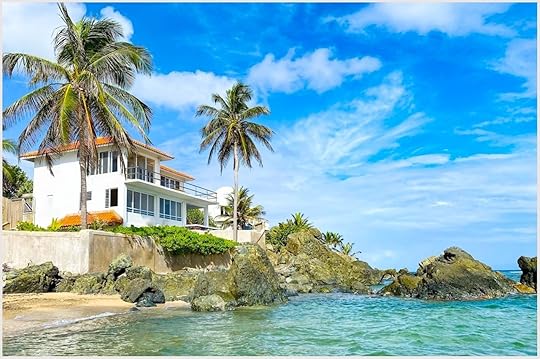
Photo: Airbnb
Only a few feet stand between this oceanfront villa and the sand of La Chata Beach on Vieques. Conveniently located just minutes from the center of town but still tucked away for a luxurious secluded feel, ‘Las Piedras’ is one of the best Airbnbs in Puerto Rico.

Photo: Airbnb
It’s a well-designed villa built in the ’80s by a prominent magazine publisher as a place of refuge from city life. The property was recently renovated and has multiple decks, a cliffside pool, and direct, private beach access. La Chata beach is a bit of a local’s secret — it’s a hotspot for snorkeling, whale watching, and a nesting site for sea turtles.
Eight guests, five bedrooms
Price: $850 per night
Tucked away in Purto Rico’s central mountain region, Cayey is full of scenic landscapes and gastronomy worth road-tripping for.
11. Luxury villa in the heart of Cayey’s mountains
Photo: Airbnb
This luxurious, hillside villa is tucked away in peace in the mountain town of Cayey. Perfect for a medium-sized group, Casamerica is a villa with the home-like feeling of a cabin.

Photo: Airbnb
The interiors are designed with earthy tones — from deep brown woods to lush greens. When this host said luxury, they meant it. There are two decks: wine and brunch, a koi fish pond, an infinity pool, and jacuzzis with a mountain view in the master bedroom. If you’re planning for a retreat or staycation, this is one of the best Airbnbs in Puerto Rico.
Eight guests, four bedrooms
Price: $1,200 per night
Home to the incredible El Yunque National Forest, Luquillo can’t be missed. Known as la Capital del Sol (“the Sun’s Capital”), it’s a beach lovers paradise.
12. Tropical villa surrounded by the rainforest in Luquillo
Photo: Airbnb
Worship the sun in Luquillo — located just thirty minutes away from San Juan’s airport — at this tropical hideout. Surrounded by the rainforest, the estate is one of the best Airbnbs in Puerto Rico for large groups.

Photo: Airbnb
The 4,000 square feet of space includes a private pool, ample garden space, and even a small soccer field. When you’re not luxuriating villa side, Luquillo has more than 12 miles of coastline and calls El Yunque National Forest its neighbor. Spend a day hiking the forest and jumping in swimming holes, and by night, dine al fresco at Los Kioskos de Luquillo, a roadside strip of bars and restaurants.
Sixteen guests, six bedrooms
Price: $644 per night

Photo: Airbnb
Located along an untouched strip of La Pared surf beach, this romantic home is just a short walk from top restaurants like BLANK — the perfect date night spot.

Photo: Airbnb
Rest well knowing that the one-bedroom condo is quiet, features modern appliances and decor, and has a large balcony for all the sunset watching opportunities Luquillo offers.
Two guests, one bedroom
Price: $160 per night
Monte Carmelo is a peaceful neighborhood tucked away in the heart of Vieques. Surrounded by mountains and tuckered behind trees, it’s the perfect place to get off the grid for a little bit.
14. Oceanside villa with rooftop deck for stargazing
Photo: Airbnb
Spend your days poolside and your nights stargazing from the roof deck of this private hilltop villa. Modernly designed for relaxation and luxury, hammocks hug the villa’s palm-lined terrace, and an outdoor shower stands just beyond the saltwater pool.

Photo: Airbnb
There are two bedrooms available — the master bedroom features a queen bed with french double doors that open up to a private deck overlooking the ocean. The second bedroom has two cozy single beds making this villa perfect for small families. If you ever decide to leave this haven, the nature of Vieuqs awaits you with easy-to-love beaches like Playa Esperanza. 
Four guests, two bedrooms
Price: $360 per night
November 5, 2021
Watch: An underwater volcano turned Japan’s coastline into waves of pumice

Months after an undersea volcano erupted on August 12, 2021, huge amounts of pumice have appeared around Japan’s southernmost coastlines.
The active Fukutoku-okanoba submarine volcano is located about 80 feet under the surface of the Pacific Ocean and 621 miles south of Tokyo. One of NASA’s satellites captured an image of the unusually large huge plume of gas and steam that extended 11 miles up into the air. Several Philippines Airlines flights were cancelled to keep ash from damaging the aircrafts’ jet engines. It was an impressive feat of nature and a little disruptive.
But the story of Fukutoku-okanoba doesn’t stop there.

Photo: Earth Observatory NASA
On August 17, another satellite image showed vast rafts of pumice floating around the caldera of the volcano. And they kept floating until, in late October, they showed up on Japan’s coastlines.
近くで見ると、なかなか衝撃的。改めて、歴史的なできごとだと思う。この先、何百年だっても「昔、与論の海が軽石だらけになったことがあるんだって」って語り継がれてほしい。「昔、与論の砂浜は真っ白だったんだって」にならないことを願う。
「軽石を分析する会」とかやってほしいな… pic.twitter.com/996DuhaMYv
— 箱山康子 | ライター・校正者 (@yasukonotes) October 23, 2021
According to the Global Volcanism Program, the pumice arrived first at Kitadaito Island on October 8 and later made its way to the Okinawa Prefecture, as well as several ports in the Kagoshima prefecture on the southern part of island of Kyushu.
Pumice is a very porous rock that’s formed during explosive volcanic eruptions. Pumice floats on water, and according to NASA’s Earth Observatory, “Rafts of the rock can drift in the ocean for months or even years.”
The tons of floating pumice from Fukutoku-okanoba has wrecked havoc every where it’s drifted. It’s clogged harbors and beaches, killed marine wildlife, damaged boats and engines, and severely disrupted the fishing industry, The Guardian reports.
Photos taken by Síle Nic Chormaic, an Irish Physicist living in Japan, show the extent of the pumice invasion.
Pumice on #Okinawa #volcanoes #Japan pic.twitter.com/fcLjhGbacV
— Prof. Síle Nic Chormaic (PhD) (@SileNicChormaic) October 30, 2021
Chormaic also captured a video of her running her hand through the unbelievably thick layer of pumice in the water.
Pumice on #Okinawa pic.twitter.com/aBvkNRJGhs
— Prof. Síle Nic Chormaic (PhD) (@SileNicChormaic) October 30, 2021
Local authorities have started clearing the tens of tons of pumice with diggers. The clean-up operation is expected to take weeks. 
Island nations leaders make a plea for change at COP26 this week

World leaders have gathered in Glasgow, Scotland, to take part in the COP26 climate summit. The summit comes six years after more than 190 countries signed the Paris Agreement to limit rising global temperatures to less than two degrees Celsius above pre-industrial levels, with the aim of reaching 1.5 degrees Celsius. The two-week event, from October 31 to November 12, will see leaders from over 190 countries, thousands of negotiators, and countless environmentalists endeavor to draft a global response to the threat of climate change.
More nations than ever are pledging to reduce emissions, move away from coal, eliminate deforestation, and deliver money to help developing nations adapt to climate change. Environmental groups and developing nations aren’t optimistic.
“Our people are watching, and our people are taking note,” declared Prime Minister Mia Mottley of Barbados. “Can there be peace and prosperity if one-third of the world lives in prosperity and two-thirds live underseas and face calamitous threats to our wellbeing?”
Samoan environmentalist Brianna Fruean addressed similar concerns while recognizing the perseverance of her fellow Pacific Islanders.
“We are not just victims to this crisis,” Fruean proclaimed. “We have been resilient beacons of home. Pacific youth have rallied behind the cry: ‘We are not drowning. We are fighting.’ This is our warrior cry to the world. We are not drowning. We are fighting. This is my message from earth to COP.”
Poet and activist Kathy Jetn̄il-Kijiner also delivered a rousing speech as a climate envoy for the Republic of the Marshall Islands, a sprawling nation of more than 1,200 low-lying atolls and islands in the Pacific Ocean. Her words beautifully highlight the plight of those fighting for their homelands’ very existence.
Leaders from the largest nations, and worst offenders, showed up to COP26 as well — most notably the United States after being absent for the last four years. President Biden promised to show the world that the US is “leading by the power of our example.”
The absences of President Xi Jinping of China, Vladimir V. Putin of Russia, and Jair Bolsonaro of Brazil were notable.
Talks will continue through next week when, hopefully, some concrete steps forward are put in place. UN Secretary-General Antonio Guterres reiterated the urgency for such measures.
“Enough of treating nature like a toilet,” Guterres proclaimed. “Enough of burning and drilling and mining our way deeper.”
Perhaps Swedish activist Greta Thunberg summed up the call to action best with a retweeted appeal for supporters to sign an open letter accusing world leaders of betrayal.
“This is not a drill,” Thunberg wrote. “It’s code red for the Earth. Millions will suffer as our planet is devastated — a terrifying future that will be created, or avoided, by the decisions you make. You have the power to decide.” 
North America is in prime viewing position for the longest lunar eclipse of the century

The longest partial lunar eclipse of the 21st century will take place overnight on November 18 and 19, 2021. And if you’re in North America, you’re golden: You’ll be able to see the entire eclipse, which NASA predicted will last three hours, 28 minutes, and 23 seconds.

The darker shades show the areas where the eclipse will be the most visible. Photo: NASA/JPL-Caltech
While the must-see celestial event is technically a partial lunar eclipse, the experts at astronomy website EarthSky explain that “With a just thin sliver of the moon exposed to direct sun at maximum eclipse, the rest of the moon should take on the characteristically ruddy colors of a total lunar eclipse.”
Lunar eclipses take place when the earth blocks the sun’s light and projects its shadow on the full moon. During a total lunar eclipse, the moon takes on shades of red and orange in a phenomenon called a blood moon.

Photo: Foto2rich/Shutterstock
If the sky is clear where you are and the moon is above the horizon, you should be able to see this exceptional partial lunar eclipse starting at 2 AM with the peak at 4 AM for those on the East Coast, and starting at 11 PM with a 1 AM peak for those on the West Coast.
Unlike with a solar eclipse, you don’t need to wear special glasses to protect your eyes from the light. You don’t even need special equipment to see this partial lunar eclipse at all — the naked eye is enough.
For a total lunar eclipse visible in the whole of North America, you’ll need to wait until March 14, 2025. Alternatively you can plan a trip around the next total lunar eclipses by checking out Matador Network‘s list of the next 10 total lunar eclipses taking place around the world. And if that’s solar eclipses that you’re after, we’ve got the next 10 total solar eclipses all sorted out for you, too. 
7 epic hotels and resorts in Colorado’s Summit County

Non-Coloradans may not recognize the name Summit County, but there’s a good chance they’re familiar with what’s there. Way up in the Rockies, the central Colorado county plays host to some of the state’s most iconic ski resorts, including Breckenridge and Keystone, which locals know have just as much to offer travelers in the off-season. Whether you come for the snow or sun is up to you. But anyone with a love of the outdoors should experience this region of the US at least once in their lives. Here are seven of the best hotels in Summit County, Colorado.
We hope you love the spaces and stays we recommend! Just so you know, Matador may collect a small commission from the links on this page if you decide to book a stay. Listed prices are accurate as of the time of publication. See our full Advertiser Disclosure here.
1. Gravity Haus
Photo: Gravity Haus
Gravity Haus is like a modern Swiss chalet that’s conveniently located in the Village at Breckenridge, right at the foot of Peak 9 a few minutes away from the QuickSilver SuperChair. Downtown Breckenridge is equally accessible on foot, making the hotel a great all-season accommodation.

Photo: Gravity Haus
There’s plenty to keep guests entertained on the property, as well, from onsen-style hot tubs and an outdoor trampoline to what some reviewers have called the best coffee bar in Breckenridge. Even the stylish lounge feels like a fun place to pass the time.
Price: $180 per night
2. Hotel Frisco
Photo: Hotel Frisco
Located in downtown Frisco, this well-priced hotel is one of the best hotels in Summit County and makes a great base for anyone wanting to experience multiple Summit County ski resorts in one trip.
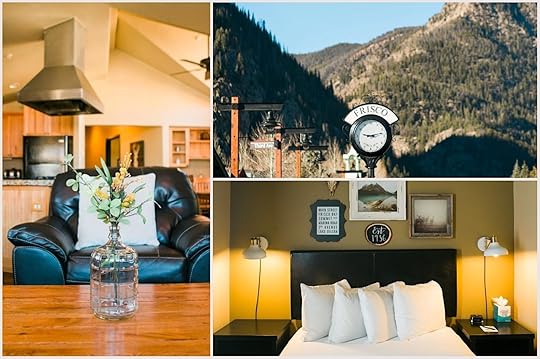
Photo: Hotel Frisco
Copper Mountain is just 10 minutes away, Breckenridge is an easy 15-minute drive, and Keystone is only 20 minutes away. Those looking to venture farther can also get to vail in just half an hour. While the hotel itself is relatively simple, amenities like a shared library and apres-ready lounge really sell the coziness.
Price: $130 per night
3. One Ski Hill Place
Photo: Booking.com
Another ski-in, ski-out accommodation, One Ski Hill Place sits at the base of Peak 8 a stone’s throw from the BreckConnect Gondola. It’s laid-back yet luxurious, with a variety of apartments and condos to accommodate groups of all sizes.

Photo: Booking.com
Each comes with a private balcony and fireplace. Breakfast is included, and for everything else, there are three separate restaurants, a cafe, and a bar-lounge on site. Beyond the slopes, guests of One Ski Hill Place are a short drive from cultural attractions like the Edwin Carter Museum and Breckenridge Riverwalk Center.
Price: $309 per night
4. Keystone Lodge and Spa
Photo: Keystone Resort
Keystone lacks Breckenridge’s mountain-town feel and apres scene, but it’s an excellent choice for travelers who have tunnel vision for Summit County’s outdoor offerings.

Photo: Keystone Resort
Slope hounds will appreciate the lodge’s Gondola Express shuttle service and complimentary ski check. Summer visitors have as many opportunities at their doorstep, from golfing and mountain biking to paddleboarding on the Snake River. Regardless of the weather, the spa here is not to be missed, with treatment rooms for both singles and couples, a hydro-therapy room, a nail salon, and more.
Price: $180 per night
5. Crystal Peak Lodge
Photo: Booking.com
Breckenridge’s Crystal Peak Lodge specializes in condo-style accommodations that are great for families, with two movie centers, a game room, and a casual-chic New American restaurant on site. Hotel guests are also welcome to enjoy the hot tub at indoor pools at the nearby One Ski Hill Place hotel.

Photo: Booking.com
Located at the base of Peak 7 near the Independence SuperChair Gondola, the ski-in, ski-out lodge also has a dedicated stop on the BreckConnect Gondola, making trips to Peak 8 and downtown Breckenridge a breeze.
Price: $250 per night
6. Mountain Thunder Lodge
Photo: Booking.com
Guests of the Mountain Thunder Lodge are provided all the amenities necessary to feel at home in Breckenridge, regardless of how long they stay. The townhouse-style accommodations come with gas fireplaces, private balconies, and well-equipped kitchens, as well as access to the hotel gym, heated outdoor pool, and hot tubs.

Photo: Booking.com
The lodge’s location is a boon too, with the BreckConnect Gondola just 650 feet away and the Breckenridge Golf Club just 10 minutes from the property. No matter the month you visit, the Mountain Thunder Lodge has you covered.
Price: $250 per night
7. The Lodge at Breckenridge
Photo: The Lodge at Breckenridge
The Breckenridge ski resort is not only one of the best hotels in Summit County it also lays claim to the highest chairlift in North America, the Imperial Express Superchair. The Lodge at Breckenridge shares a similar distinction as one of the highest-altitude hotels in the world. Come ski season, shuttles are available to transport guests to Breckenridge’s slopes, while the Keystone and Arapahoe Basin ski areas are a mere 10 miles away. Back at the lodge, the skiers and non-skiers in your group will take equal pleasure in winding down at the on-site Traverse Restaurant followed by a soak in the spa’s two hot tubs, all under the watchful gaze of the majestic Rockies. 
Price: $165 per night
More like thisOutdoorWhy Colorado’s Breckenridge ski resort is even better in the summerMatador Network's Blog
- Matador Network's profile
- 6 followers



